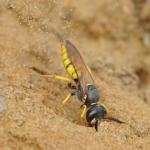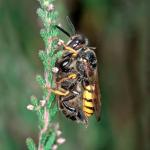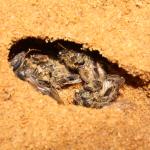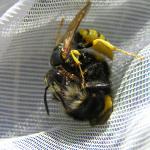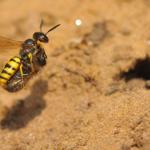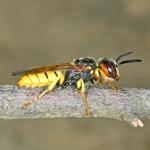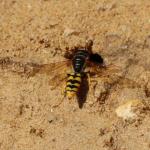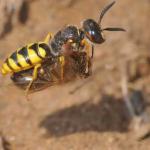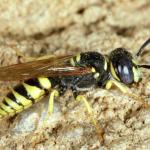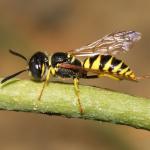Less than 20 years ago, this magnificent wasp, commonly known as the 'bee wolf' or ‘bee-killer' was considered to be one of the great aculeate rarities in Britain. Records for the last few years indicate that currently the species is locally common to abundant in a steadily increasing number of sites in southern England, with a single record for north Wales (Else, 1993a, 1995a,b,e).
This species was regarded as Vulnerable (RDB2) in Shirt (1987) and Falk (1991). In view of the recent expansion of its range, this status should be revised.
Generally, sand dunes and lowland heaths. However, nesting aggregations have recently been found in a park in Ipswich, Suffolk, and on the Battersea Bridge roundabout, Greater London.
From early July to mid-September. In England there appears to be a single brood, but in central Europe a second generation is known (Lomholdt, 1975).
The major prey species throughout the world range of this wasp is the worker honey bee (Apis mellifera), and in some regions the wasp may greatly reduce the local populations (El-Borollosy, Wafa & El-Hefny, 1972). There are, however, reports of other bees being utilised: for example in Britain, Andrena flavipes and Lasioglossum zonulus (Smith, 1851a), and a Nomada sp. (C O'Toole, pers. comm.).
This wasp nests in both level sandy exposures and in vertical soil faces. Some nesting aggregations may number as many as 15,000 burrows (Else 1995a,b). The main nest burrow may be up to 1 m in length, with 3-34 short lateral burrows at the end, each terminating in a cell (Lomholdt, 1975). The prey is paralysed by being stung through the articular membranes immediately behind the front legs (Rathmayer, 1962). Returning females, clutching the prey with their legs, often hover above the nest burrow before slowly descending to it. Nesting biology and behaviour are described by Curtis (1829), Olberg (1953, 1959), El-Borollosy et al. (1972), Lomholdt (1975), Simon Thomas (1966), Simon Thomas and Simon Thomas (1972), Simon Thomas and Veenendaal (1978), Tinbergen (1932, 1958, 1969, 1974) and Vergne (1935). Olberg's (1959) publication is particularly good for descriptions and illustrations of nest construction and provisioning.
Nectar sources include bramble, sea-holly, heather, thrift, pale toadflax, common ragwort, hemp-agrimony and creeping thistle.
1997


